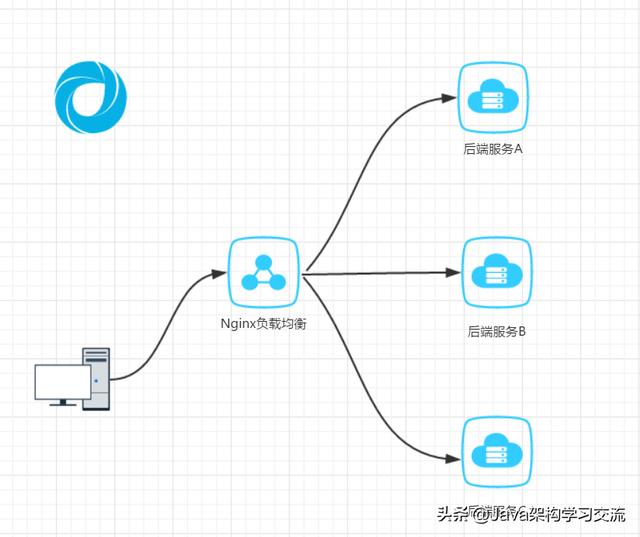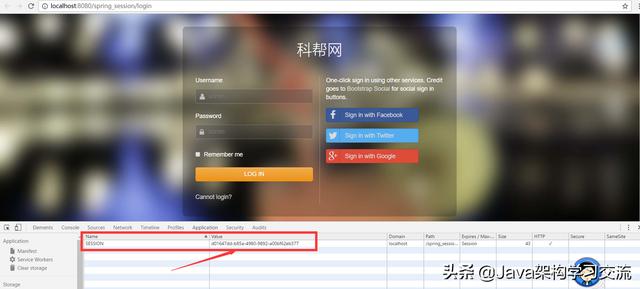前言
通常在web开发中,会话管理是很重要的一部分,用于存储与用户相关的一些数据。对于JAVA开发者来说,项目中的session一般由 Tomcat 或者jetty容器来管理。
特点介绍
尽管使用特定的容器可以很好地实现会话管理,但是独立容器挂掉或者由于其他原因重启会导致用户信息丢失,并且无法支持分布式集群会话管理。
上图举例:

这是一个简单的负载均衡集群架构模型,后端三台Tomcat服务,假设每台服务都使用自己的会话管理,而集群策略是基于加权轮询的方式实现。试想一下,用户是不是永远无法登陆系统?
当然,你可能会想,我可以使用基于IP_hash的方式实现负载均衡嘛。但是如果地区分布相对单一,产生的hash值分布可能也不会太均匀,那就起不到负载均衡的作用了。
一般来说,有两种解决方案,session复制和session统一管理。对于session复制,简单的几台还是可以的,但是如果上百台甚至上千台就要考虑复制成本问题了。
对于统一session管理可以是关系型数据库,比如 MySql (基本不用,考虑到效率问题);非关系型数据库 redis ,memcache等等。
解决方案
- 基于Tomcat的会话插件实现tomcat-redis-session-manager 和tomcat-memcache-session-manager,会话统一由NoSql管理。对于项目本身来说,无须改动代码,只需要简单的配置Tomcat的server.xml就可以解决问题。但是插件太依赖于容器,并且对于Tomcat各个版本的支持不是特别的好
- 重写Tomcat的session管理,代码耦合度高,不利于维护。
- 使用开源的session管理框架,比如spring_session,既不需要修改Tomcat配置,又无须重写代码,只需要配置相应的参数即可。
功能实现
下面,主要是基于spring_session实现的分布式集群会话管理案例。
项目需要使用到spring_Mvc4.2.5,spring_session-1.2.2和redis-3.2.8(需要自行安装redis服务)。
下载相关JAR包:
<dependency> <groupId>org.springframework.session</groupId> <artifactId>spring-session-data-redis</artifactId> <version>1.2.2.RELEASE</version> </dependency>
spring-mvc.xml
<?xml version="1.0" encoding="UTF-8"?> <beans xmlns="#34; xmlns:xsi="#34; xmlns:context="#34; xmlns:mvc="#34; xsi:schemaLocation=" #34;> <description>Spring MVC config uration</description> <!-- 加载配置属性文件 --> <context:property-placeholder ignore-unresolvable="true" location="classpath:config.properties" /> <!-- 使用 annotation 自动注册Bean,只扫描@Controller --> <context:component-scan base-package="com.itstyle.web" use-default-filters="false"><!-- base-package 如果多个,用“,”分隔 --> <context:include-filter type="annotation" expression="org.springframework.stereotype.Controller"/> </context:component-scan> <mvc:annotation-driven/> <!--启动Spring MVC的注解功能,设置编码方式,防止乱码--> <bean class="org.springframework.web. servlet .mvc.annotation.AnnotationMethodHandlerAdapter"> <property name="messageConverters"> <list> <bean class = "org.springframework.http.converter.StringHttpMessageConverter"> <property name = "supportedMediaTypes"> <list> <value>text/html;charset=UTF-8</value> </list> </property> </bean> </list> </property> </bean> <!-- REST中根据URL后缀自动判定Content-Type及相应的View --> <bean id="contentNegotiationManager" class="org.springframework.web.accept.ContentNegotiationManagerFactoryBean"> <property name="mediaTypes" > <map> <entry key="xml" value="application/xml"/> <entry key="json" value="application/json"/> </map> </property> <property name="ignoreAcceptHeader" value="true"/> <property name="favorPathExtension" value="true"/> </bean> <!-- 定义视图文件解析 --> <bean class="org.springframework.web.servlet.view.InternalResourceViewResolver"> <property name="prefix" value="${web.view.prefix}"/> <property name="suffix" value="${web.view.suffix}"/> </bean> <!-- 对静态资源文件的访问, 将无法mapping到Controller的path交给default servlet handler处理 --> <mvc:default-servlet-handler /> <!-- 静态资源映射 SpringMVC会自动给静态资源Response添加缓存头Cache-Control和Expires值 cache-period="31536000"--> <mvc:resources mapping="/static/**" location="/static/" /> <!-- 定义无Controller的path<->view直接映射(首页或者登陆页) --> <mvc:view-controller path="/" view-name="redirect:${web.view.login}"/> </beans>
config.properties
#============================# #===== System settings ======# #============================# #产品信息设置 productName=科帮网 srping session copyrightYear=2017 version=V1.0.0 #分页配置 page.pageSize=10 #索引页路径 web.view.index=/index #登陆页面 web.view.login=/login #视图文件存放路径 web.view.prefix=/WEB-INF/views/ web.view.suffix=.jsp #静态文件后缀 web.staticFile=.css,.js,.png,.jpg,.gif,.jpeg,.bmp,.ico,.swf,.psd,.htc,.htm,.html,.crx,.xpi,.exe,.ipa,.apk
spring-redis.xml
<?xml version="1.0" encoding="UTF-8"?>
<beans xmlns="#34;
xmlns:xsi="#34; xmlns:context="#34;
xmlns:aop="#34; xmlns:tx="#34;
xsi:schemaLocation="
#34; default-autowire="byName" default-lazy-init="true">
<!-- 加载资源文件 其中包含变量信息,必须在Spring配置文件的最前面加载,即第一个加载-->
<context:property-placeholder location="classpath:redis.properties" />
<!-- redis -->
<bean id="jedisPoolConfig" class="redis.clients.jedis.JedisPoolConfig"/>
<bean id="jedisConnectionFactory"
class="org.springframework.data.redis.connection.jedis.JedisConnectionFactory">
<property name="hostName" value="${redis.host}" />
<property name="port" value="${redis.port}" />
<property name="password" value="${redis.password}" />
<property name="timeout" value="${redis.timeout}" />
<property name="poolConfig" ref="jedisPoolConfig" />
<property name="usePool" value="true" />
</bean>
<bean id="redisTemplate" class="org.springframework.data.redis.core.StringRedisTemplate">
<property name="connectionFactory" ref="jedisConnectionFactory" />
</bean>
<!-- 将session放入redis -->
<context:annotation-config/>
<bean id="redisHttpSessionConfiguration" class="org.springframework.session.data.redis.config.annotation.web.http.RedisHttpSessionConfiguration">
<property name="maxInactiveIntervalInSeconds" value="1800" />
</bean>
</beans>
redis.properties
#redis中心 redis.host=127.0.0.1 redis.port=6379 redis.password=123456 redis.maxIdle=100 redis.maxActive=300 redis.maxWait=1000 redis.testOnBorrow=true redis.timeout=100000
web.xml
<?xml version="1.0" encoding="UTF-8"?> <web-app id="WebApp_ID" version="2.4" xmlns="#34; xmlns:xsi="#34; xsi:schemaLocation=" #34;> <display-name>spring_session</display-name> <context-param> <param-name>contextConfigLocation</param-name> <param-value>classpath:spring-redis.xml</param-value> </context-param> <!-- spring session --> <filter> <filter-name>springSessionRepositoryFilter</filter-name> <filter-class>org.springframework.web.filter.DelegatingFilterProxy</filter-class> </filter> <filter-mapping> <filter-name>springSessionRepositoryFilter</filter-name> <url-pattern>/*</url-pattern> </filter-mapping> <listener> <listener-class>org.springframework.web.context.ContextLoaderListener</listener-class> </listener> <filter> <filter-name>encodingFilter</filter-name> <filter-class>org.springframework.web.filter.CharacterEncodingFilter</filter-class> <init-param> <param-name>encoding</param-name> <param-value>UTF-8</param-value> </init-param> <init-param> <param-name>forceEncoding</param-name> <param-value>true</param-value> </init-param> </filter> <filter-mapping> <filter-name>encodingFilter</filter-name> <url-pattern>/*</url-pattern> </filter-mapping> <servlet> <servlet-name>springServlet</servlet-name> <servlet-class>org.springframework.web.servlet.DispatcherServlet</servlet-class> <init-param> <param-name>contextConfigLocation</param-name> <param-value>classpath*:/spring-mvc*.xml</param-value> </init-param> <load-on-startup>1</load-on-startup> </servlet> <servlet-mapping> <servlet-name>springServlet</servlet-name> <url-pattern>/</url-pattern> </servlet-mapping> <welcome-file-list> <welcome-file>login</welcome-file> </welcome-file-list> </web-app>
测试功能
最后,启动项目访问

登录redis服务,执行以下命令:
KEYS *

注意,对比sessionId是一致的。
网上很多同学,启动的时候找不到 springSessionRepositoryFilter,注意在spring-redis.xml加入<context:annotation-config/> 配置即可。


